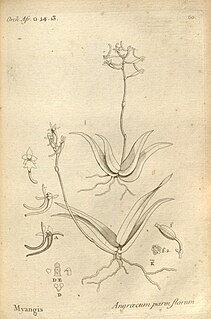
Tabernaemontana is a genus of flowering plants in the family Apocynaceae. It has a pan-tropical distribution, found in Asia, Africa, Australia, North America, South America, and a wide assortment of oceanic islands. These plants are evergreen shrubs and small trees growing to 1–15 m tall. The leaves are opposite, 3–25 cm long, with milky sap; hence it is one of the diverse plant genera commonly called "milkwood". The flowers are fragrant, white, 1–5 cm in diameter.
Erythrococca is a plant genus of the family Euphorbiaceae, first described in 1849. It is native to Africa and the Arabian Peninsula.
Grossera is a plant genus of the family Euphorbiaceae first described as a genus in 1903. It is native to Madagascar and to mainland tropical Africa.
- Grossera angustifoliaBarbera&Riina - Equatorial Guinea
- Grossera elongataHutch. - Príncipe
- Grossera glomeratospicataJ.Léonard - East Congo
- Grossera macranthaPax - East Congo, West Congo, Cameroon, Central African Rep.
- Grossera majorPax - Cameroon
- Grossera multinervisJ.Léonard - East Congo, São Tomé
- Grossera paniculataPax - West Congo, Cameroon, Gabon
- Grossera perrieriLeandri - Madagascar
- Grossera vigneiHoyle - Ivory Coast, Ghana, West Congo
Oldfieldia is a plant genus under the family Picrodendraceae, the only member of its subtribe (Paiveusinae). It was described as a genus in 1850.
Maesobotrya is a genus of flowering plant belonging to the family Phyllanthaceae first described as a genus in 1879. It is native to sub-Saharan Africa.

Drypetes is a plant genus of the family Putranjivaceae, in the order Malpighiales.
The individual member states of the African Union (AU) coordinate foreign policy through this agency, in addition to conducting their own international relations on a state-by-state basis. The AU represents the interests of African peoples at large in intergovernmental organizations (IGO's); for instance, it is a permanent observer at the United Nations' General Assembly.

The grey-throated rail is a species of bird in the family Rallidae, the only member of the genus Canirallus. It is found in Cameroon, Central African Republic, Republic of the Congo, Democratic Republic of the Congo, Ivory Coast, Equatorial Guinea, Gabon, Ghana, Guinea, Liberia, Nigeria, and Sierra Leone.

Angraecopsis is a genus of plants in the family Orchidaceae. It was first described by Fritz Kraenzlin in 1900 and given its name on account with the genus' similarity to Angraecum species. Angraecopsis are native to Africa, Madagascar, Réunion, Mauritius and the Comoros. The growth habit is rather small and the leaves emerge from a woody stem.

Marantochloa is a genus of plant in family Marantaceae described as a genus in 1860. It is native to tropical Africa and to islands in the Indian Ocean.

Mimusops is a genus of plants in the family Sapotaceae described as a genus by Linnaeus in 1753.
Auxopus is a genus of the family Orchidaceae. It belongs to the tribe Gastrodieae.
Leptosia nupta, the immaculate wood white, petite wood white or immaculate spirit, is a butterfly in the family Pieridae. It was described by Arthur Gardiner Butler in 1873. It is found in Nigeria, Cameroon, Gabon, the Republic of the Congo, Angola, the Democratic Republic of the Congo, Uganda, Rwanda, Kenya, Tanzania, Zambia, Zimbabwe and on Madagascar. The habitat consists of wet, primary forest.
Charaxes richelmanni is a butterfly in the family Nymphalidae. It is found in Cameroon, Gabon, the Republic of Congo, the Central African Republic, the Democratic Republic of Congo and Tanzania. The habitat consists of lowland evergreen forests.
Cremaspora is a genus of flowering plants in the family Rubiaceae. It is the only genus in the tribe Cremasporeae. It was described by George Bentham in 1849. The genus is widespread across much of sub-Saharan Africa from Senegal to Tanzania and south to Mozambique and Zimbabwe, in addition to Madagascar, Comoros, and Cape Verde. There are, however, only two currently recognized species.

Landolphia is a genus of flowering plants in the family Apocynaceae first described as a genus in 1806. They take the form of vines that scramble over host trees. Landolphia is native to tropical Africa.
Petersianthus is a genus of woody plant in the Lecythidaceae family first described as a genus in 1865 under the name Petersia. This turned out to be an illegitimate homonym, meaning that it had already been used by someone else to refer to a very different plant. So the name of these species in the Lecythidaceae was changed to Petersianthus. It is native to the Philippines and to parts of Africa.
- Petersianthus macrocarpus(P.Beauv.) Liben - Guinea, Ivory Coast, Cameroon, Congo Republic, Democratic Republic of the Congo, Cabinda, Gabon, Angola
- Petersianthus quadrialatus(Merr.) Merr. - Philippines

Coptops aedificator is a species of beetle in the family Cerambycidae. It was described by Johan Christian Fabricius in 1792, originally under the genus Lamia. It is known from Djibouti, Tanzania, the Democratic Republic of the Congo, Ethiopia, Oman, Gabon, India, Madagascar, Malawi, Namibia, Nigeria, Saudi Arabia, the Ivory Coast, Cameroon, Senegal, South Africa, Seychelles, Mauritius, Sri Lanka, and Zambia. It was also introduced into Cape Verde, Hawaii, and Taiwan. It feeds on Theobroma cacao and several Coffea species, including C. arabica, C. canephora, and C. liberica var. dewevrei.







